
Price based on lowest available cruise only fare for double occupancy. Subject to change at any time.
Your dream holiday awaits on Norwegian Jade. Sail on a Mediterranean cruise and explore castles, cathedrals, romantic islands, and sophisticated cities. Witness scenery on an Africa cruise as wild and diverse as the creatures that freely roam. Or embark on one of our uniquely designed Extraordinary Journeys that allow you more immersive experiences. As you cruise from port to port along stunning coastlines, we'll keep you entertained day and night with exciting nightclubs, award-winning restaurants, a grand casino, swimming pools, a pampering spa and so much more. There's tonnes of fun for kids too, so bring the whole family and enjoy the adventure of a lifetime. It's no wonder we are the World Travel Award winner for "Europe's Leading Cruise Line" 13 years in a row.
Cruise ID: 11759
We are confident that you will enjoy your Freestyle Cruising experience and that our entire crew will provide you with the standard of service for which we are known. A discretionary service charge will be automatically added per guest per day (for guests three years and older) to your shipboard account for all staterooms: all ships US$ 16 per guest per day (for guests 3 years and older) for Studios, Inside, Oceanview and Balcony Staterooms. For Club Balcony Suites, the service charge will be US$ 18 per guest per day (for guests 3 years and older) and for Suites and The Haven Suites as well as the Concierge staterooms, the service charge will be US$ 20 per guest per day (for guests 3 years and older). This charge will be shared amongst those staff members, including the restaurant staff, stateroom stewards and other behind-the scenes staff who provide services that enhance your overall cruise experience.
These service charges can be paid in advance of your cruise. If you have any concerns about the service you receive during your cruise, please let our on-board Guest Services Desk staff know right away, so we can address any issues in a timely manner. In the unlikely event that we can't resolve your issue, you can have the service charge adjusted on board. Where your service charge has been pre-paid before departure, refunds are not available on board and you must apply for a refund, if applicable, after you return home by writing to our Guest Relations department.
Certain staff positions (e.g., concierge, butler, youth programme staff and beverage service) provide service on an individual basis to only some guests and do not benefit from the overall service charge. We encourage those guests to acknowledge good service from these staff members with appropriate gratuities.
Additionally, there is a 20% gratuity and spa service charge added for all spa and salon services, as well as a 20% gratuity and beverage service charge added for all beverage purchases and a 20% gratuity and speciality service charge added to all speciality restaurant dining and entertainment based dining e.g. Cirque Dreams® and Dinner (does not apply to Free at Sea dining and drinks packages).
| Date | Time | Price * | Booking |
|---|---|---|---|
| 28 May 2024 | 17:30 | €1,718 | Call us to book |
* Price based on lowest available cruise only fare for double occupancy. Subject to change at any time.
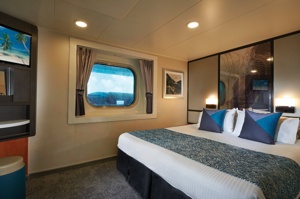
These Oceanview Staterooms sleep up to four guests and have either a picture window or porthole, with an obstructed view. Two lower beds that convert into a queen-size bed and additional bedding to accommodate two more.
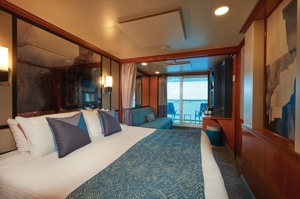
A Sail Away Club Balcony Suite stateroom guarantees a Club Balcony Suite stateroom or better! Your stateroom may be on any deck and assigned up to one day prior to embarkation.
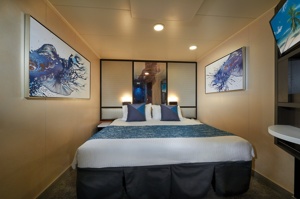
Norwegian Jade Inside Staterooms are the most affordable way for your family to cruise. With room for up to four guests, you'll have two lower beds that convert into a queen-size bed and additional bedding to accommodate two more. And of course, room service and many other amenities.
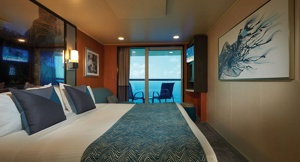
These spacious staterooms include a queen-size bed, sitting area and floor-to-ceiling glass doors that open onto a private balcony. Staterooms are priced exclusively for solo travelers.
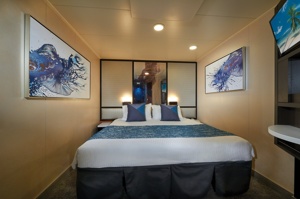
A Sail Away Inside stateroom guarantees an Inside stateroom or better! Your stateroom may be on any deck and assigned between time of booking up to one day prior to embarkation.
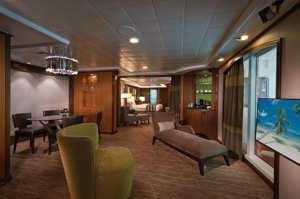
These Owner's Suites are a truly luxurious way for you to get away. Includes a separate bedroom with a king-size bed and luxury bath with separate shower, in addition to the living room, dining room and large private balconies with incredible views. Sleeps up to four and guests receive access to the private courtyard area. They also can connect to a Penthouse or Balcony stateroom so you can spread out even more. Includes butler and concierge service.
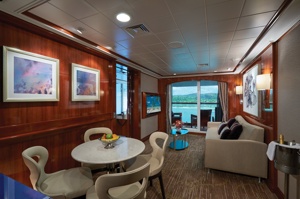
Up to six guests can enjoy these Villas that are perfect if you want to bring the kids. They have one bedroom with a queen-size bed and a luxury bath and shower, as well as a separate children's bedroom. Also features a living area, dining area and private balcony. You will also have access to the private courtyard area. Includes butler and concierge service.
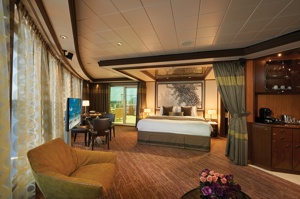
Enjoy the perfect escape in Norwegian Jade Deluxe Owner's Suites. With a living room, dining room, floor-to-ceiling glass doors and separate bedroom with king-size bed and luxury bath, you will have an unforgettable experience in this suite. Sleeps up to four and includes access to the private courtyard area. Not to mention the large balcony and amazing view. Includes butler and concierge service.
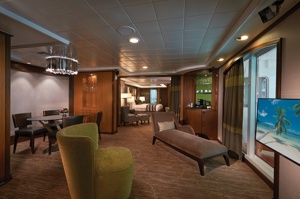
Indulge in supreme comfort and luxury in these Owner's Suites featuring a separate bedroom with a king-size bed, a double sofabed, luxury bath with a separate shower, as well as a guest bath. Also includes a living room and dining room and fabulous views from two private balconies, plus access to the private courtyard and butler and concierge service. They can also connect to a Penthouse or Balcony stateroom, perfect if travelling with friends or family.
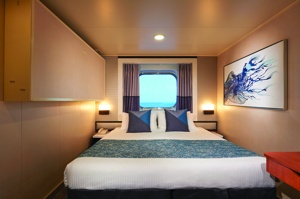
A Sail Away Oceanview stateroom guarantees an Oceanview stateroom or better! Please note that the view may be fully obstructed, partially obstructed, porthole or picture window. Your stateroom may be on any deck and assigned up to one day prior to embarkation.
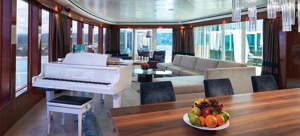
These amazing Norwegian Jade Villas sleep up to eight with three separate bedrooms, each with a king- or queen-size bed and luxury bath. With a living room, dining room and incredible private garden, you will have more than enough space to spread out and unwind. You'll also have access to the private courtyard area with a hot tub. Includes butler and concierge service.
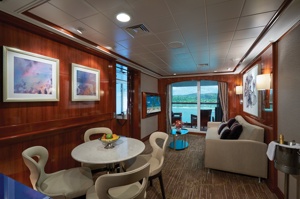
These Penthouses are perfect for your whole family. Up to six guests can stay in these luxurious Penthouses that include a bedroom with a queen-size bed and a separate children's bedroom. In addition to the living area, dining area, private balcony and luxury bath with separate shower. Includes butler and concierge service. Plus they can connect to a Mini-Suite so your group can spread out yet stay together.
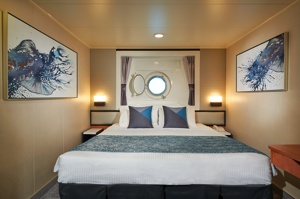
Up to four guests can stay in these Oceanview Staterooms. Includes two lower beds that convert into a queen-size bed and additional bedding to accommodate two more, as well as a porthole to enjoy the view. Some can connect so you can spread out yet stay together.
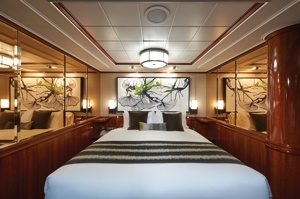
Norwegian Jade Courtyard Penthouses make for an amazing cruising experience. Sleeps three, with a bedroom featuring a queen-size bed, luxury bath and shower and additional bedding to sleep one additional guest. Also features a living area, dining area, private balcony and access to the private courtyard area. Includes butler and concierge service.
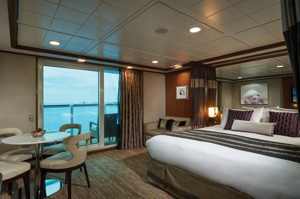
Stunning views are straight ahead from the large, private balcony of these forward-facing, luxurious Penthouses. Includes a queen-size bed, luxury bath, living and dining area. Sleeps up to three. Includes butler and concierge service. And some can connect to a Haven Owner's Suite so you can spread out in luxury.
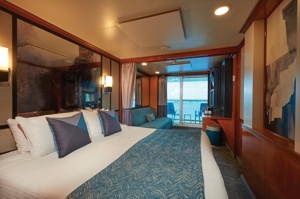
These Club Balcony Suites sleep up to four guests, making them ideal if you want to bring the kids. They have two lower beds that convert into a queen-size bed as well as a sitting area, luxury bath with shower and additional bedding to sleep two additional guests. Because they are aft-facing suites, the view from your private balcony is truly amazing. Plus some can connect so you can enjoy the views with family or friends.
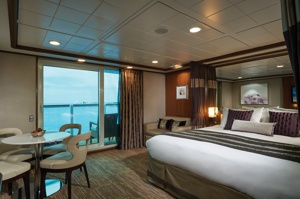
These incredible Penthouses sleep up to four, with a bedroom with queen-size bed and luxury bath and shower. Also includes a living area, dining area and large private balcony that offers an amazing view. Includes butler and concierge service.
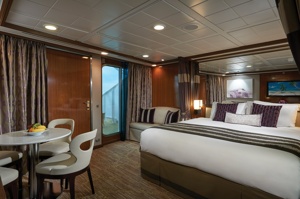
Perfect for a romantic getaway, you will fall head over heels for these fabulous Penthouses. Sleeps up to three, a bedroom with queen-size bed and luxury bath and shower, in addition to the living area, dining area and large private balcony. Includes butler and concierge service.
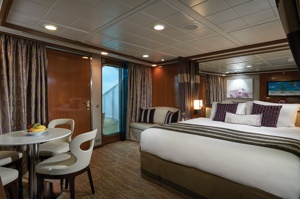
Up to three guests can enjoy the fabulous views from the aft-facing balcony of these Penthouses that include queen-size bedding plus a single sofa-bed, a sitting area, and some even have a living and dining area. Most include butler and concierge service.
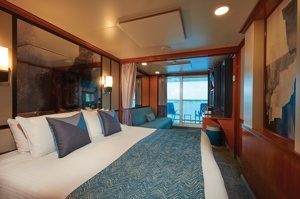
Up to four guests can stay in these Club Balcony Suites that come with a sitting area, luxury bath with shower, two lower beds that convert into a queen-size bed and additional bedding to sleep two additional guests. Not to mention you'll have a private balcony to enjoy the incredible view. Plus some can connect to other staterooms so you can spread out yet stay together.
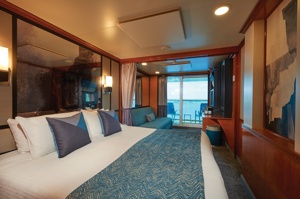
You'll enjoy every inch of these staterooms, with enough space to sleep up to four guests. The two lower beds can be converted into a queen-size bed and there's additional bedding to sleep up to two more. You'll also have a sitting area and floor-to-ceiling glass doors that open to a private balcony. Because these are aft-facing, the view from your balcony is amazing and truly unforgettable.
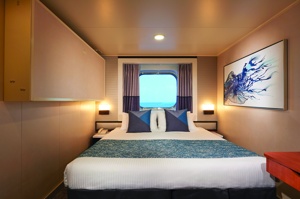
You'll enjoy an amazing view from the big picture window in these staterooms that comfortably fit up to three guests. Two lower beds convert into a queen-size bed and additional bedding to accommodate one more. Of course, you'll have room service and many other amenities. Plus some can connect, giving your group more options to spread out yet stay together.
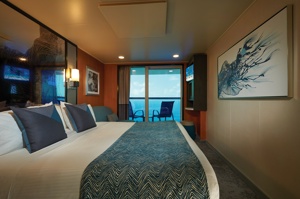
Norwegian Jade staterooms are perfect if you want to bring the whole family. With room for up to four guests, there are two lower beds that convert into a queen-size bed, one pullman and one single sofa-bed. Also includes a sitting area and floor-to-ceiling glass doors that open to a private balcony. Many can connect to other staterooms so you can enjoy the views together.
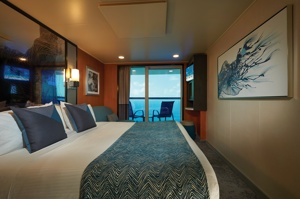
Balcony staterooms come with two lower beds that convert into a queen-size bed, and additional bedding for up to two guests. Also includes a sitting area and floor-to-ceiling glass doors that open to a private balcony. Some also can connect, offering more options when travelling with family or friends.
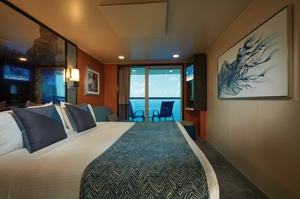
A Sail Away Balcony stateroom guarantees a Balcony stateroom or better! Please note that the view from your balcony may be fully obstructed or partially obstructed. Your stateroom may be on any deck and assigned up to one day prior to embarkation.
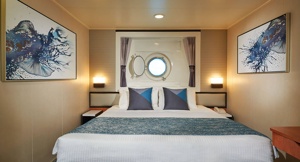
These staterooms feature a large round window and a queen-size bed. Staterooms are priced exclusively for solo travelers.
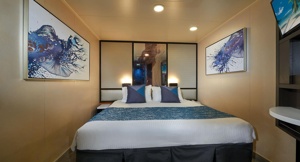
These staterooms include a queen-size bed and the same amenities as other inside staterooms. Staterooms are priced exclusively for solo travelers.
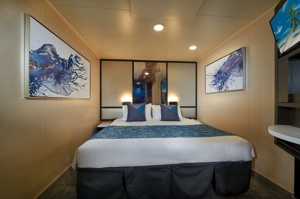
These Inside Staterooms are the most affordable way to cruise. There's room for up to four guests and they include two lower beds that convert into a queen-size bed and of course, you'll have room service and many other amenities.
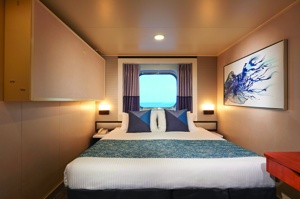
You can comfortably fit up to four guests in these staterooms, making them perfect for families. You'll enjoy an amazing view from the big picture window. Two lower beds convert into a queen-size bed and additional bedding to accommodate two more. Of course, you'll have room service and many other amenities. Plus some can connect, perfect for your group to spread out.
Day 1 Port Canaveral, Florida, United States
Widely known for the Kennedy Space Center, Port Canaveral is located in the city of Cape Canaveral, home to beautiful beaches and Brevard Zoo.
Day 2 Cruising
Day 3 Puerto Plata, Dominican Republic
San Felipe de Puerto Plata is the capital of the Puerto Plata province on the Dominican Republic's Atlantic north coast. The city is best known for its beaches. Playa Dorada's lengthy beachfront is backed by resorts and an 18-hole golf course. The city's old colonial-era center is dominated by the 16th-century Fortaleza San Felipe, a Spanish fortress that now houses historical and military artifacts.
Day 4 Cruising
Day 5 Oranjestad, Aruba
Aruba's capital is easily explored on foot. Its palm-lined central thoroughfare runs between old and new pastel-painted buildings of typical Dutch design (Spanish influence is also evident in some of the architecture). There are a lot of malls with boutiques and shops—the Renaissance mall carries high-end luxury items and designer fashions. A massive renovation in downtown has given Main Street (a.k.a. Caya G. F. Betico Croes) behind the Renaissance Resort a whole new lease on life: boutique malls, shops, and restaurants have opened next to well-loved family-run businesses. The pedestrian-only walkway and resting areas have unclogged the street, and the new eco-trolley is free and a great way to get around. At this writing, Linear Park was well and will showcase local merchants and artists. There will be activities along a boardwalk that will eventually run all the way to the end of Palm Beach, making it the longest of its kind in the Caribbean.
Day 6 Willemstad, Curaçao
Dutch settlers came here in the 1630s, about the same time they sailed through the Verazzano Narrows to Manhattan, bringing with them original red-tile roofs, first used on the trade ships as ballast and later incorporated into the architecture of Willemstad. Much of the original colonial structures remain, but this historic city is constantly reinventing itself and the government monument foundation is always busy restoring buildings in one urban neighborhood or another. The salty air causes what is called "wall cancer" which causes the ancient abodes to continually crumble over time. The city is cut in two by Santa Anna Bay. On one side is Punda (the point)—crammed with shops, restaurants, monuments, and markets and a new museum retracing its colorful history. And on the other side is Otrobanda (literally meaning the "other side"), with lots of narrow, winding streets and alleyways (called "steekjes" in Dutch), full of private homes notable for their picturesque gables and Dutch-influenced designs. In recent years the ongoing regeneration of Otrobanda has been apparent, marked by a surge in development of new hotels, restaurants, and shops; the rebirth, concentrated near the waterfront, was spearheaded by the creation of the elaborate Kura Hulanda complex.There are three ways to cross the bay: by car over the Juliana Bridge; by foot over the Queen Emma pontoon bridge (locally called "The Swinging Old Lady"); or by free ferry, which runs when the pontoon bridge is swung open for passing ships. All the major hotels outside town offer free shuttle service to town once or twice daily. Shuttles coming from the Otrobanda side leave you at Riffort. From here it's a short walk north to the foot of the pontoon bridge. Shuttles coming from the Punda side leave you near the main entrance to Ft. Amsterdam.
Day 7 Cruising
Day 8 Saint John's, Antigua and Barbuda
With its superb beaches, historical attractions and beautiful coral reefs, Antigua provides a host of diversions. It is said that the island contains 365 beaches, one for every day of the year. Antigua maintains its traditional West Indian character, with gingerbread-house style architecture, calypso music and carnival festivities. St John's has been the administrative capital since the island's colonisation in 1632, and has been the seat of government since it gained independence in 1981. From the port you can explore the colourful Redcliffe district, with its restored wooden houses, and Heritage Quay with its shopping mall and craft shops. The city has some fine examples of Colonial architecture, including the twin-towered cathedral, built in 1845 and considered one of the finest church buildings in the Caribbean. All coaches in Antigua are operated by smaller vehicles, and commentary will be given by a driver/guide.
Day 9 Saint Thomas, U.S. Virgin Islands
If you fly to the 32-square-mile (83-square-km) island of St. Thomas, you land at its western end; if you arrive by cruise ship, you come into one of the world's most beautiful harbors. Either way, one of your first sights is the town of Charlotte Amalie. From the harbor you see an idyllic-looking village that spreads into the lower hills. If you were expecting a quiet hamlet with its inhabitants hanging out under palm trees, you've missed that era by about 300 years. Although other islands in the USVI developed plantation economies, St. Thomas cultivated its harbor, and it became a thriving seaport soon after it was settled by the Danish in the 1600s. The success of the naturally perfect harbor was enhanced by the fact that the Danes—who ruled St. Thomas with only a couple of short interruptions from 1666 to 1917—avoided involvement in some 100 years' worth of European wars. Denmark was the only European country with colonies in the Caribbean to stay neutral during the War of the Spanish Succession in the early 1700s. Thus, products of the Dutch, English, and French islands—sugar, cotton, and indigo—were traded through Charlotte Amalie, along with the regular shipments of slaves. When the Spanish wars ended, trade fell off, but by the end of the 1700s Europe was at war again, Denmark again remained neutral, and St. Thomas continued to prosper. Even into the 1800s, while the economies of St. Croix and St. John foundered with the market for sugarcane, St. Thomas's economy remained vigorous. This prosperity led to the development of shipyards, a well-organized banking system, and a large merchant class. In 1845 Charlotte Amalie had 101 large importing houses owned by the English, French, Germans, Haitians, Spaniards, Americans, Sephardim, and Danes. Charlotte Amalie is still one of the world's most active cruise-ship ports. On almost any day at least one and sometimes as many as eight cruise ships are tied to the docks or anchored outside the harbor. Gently rocking in the shadows of these giant floating hotels are just about every other kind of vessel imaginable: sleek sailing catamarans that will take you on a sunset cruise complete with rum punch and a Jimmy Buffett soundtrack, private megayachts for billionaires, and barnacle-bottom sloops—with laundry draped over the lifelines—that are home to world-cruising gypsies. Huge container ships pull up in Sub Base, west of the harbor, bringing in everything from breakfast cereals to tires. Anchored right along the waterfront are down-island barges that ply the waters between the Greater Antilles and the Leeward Islands, transporting goods such as refrigerators, VCRs, and disposable diapers. The waterfront road through Charlotte Amalie was once part of the harbor. Before it was filled in to build the highway, the beach came right up to the back door of the warehouses that now line the thoroughfare. Two hundred years ago those warehouses were filled with indigo, tobacco, and cotton. Today the stone buildings house silk, crystal, and diamonds. Exotic fragrances are still traded, but by island beauty queens in air-conditioned perfume palaces instead of through open market stalls. The pirates of old used St. Thomas as a base from which to raid merchant ships of every nation, though they were particularly fond of the gold- and silver-laden treasure ships heading to Spain. Pirates are still around, but today's versions use St. Thomas as a drop-off for their contraband: illegal immigrants and drugs. To explore outside Charlotte Amalie, rent a car or hire a taxi. Your rental car should come with a good map; if not, pick up the pocket-size "St. Thomas–St. John Road Map" at a tourist information center. Roads are marked with route numbers, but they're confusing and seem to switch numbers suddenly. Roads are also identified by signs bearing the St. Thomas–St. John Hotel and Tourism Association's mascot, Tommy the Starfish. More than 100 of these color-coded signs line the island's main routes. Orange signs trace the route from the airport to Red Hook, green signs identify the road from town to Magens Bay, Tommy's face on a yellow background points from Mafolie to Crown Bay through the north side, red signs lead from Smith Bay to Four Corners via Skyline Drive, and blue signs mark the route from the cruise-ship dock at Havensight to Red Hook. These color-coded routes are not marked on most visitor maps, however. Allow yourself a day to explore, especially if you want to stop to take pictures or to enjoy a light bite or refreshing swim. Most gas stations are on the island's more populated eastern end, so fill up before heading to the north side. And remember to drive on the left!
Day 10 Cruising
Day 11 Great Stirrup Cay, Bahamas
Located 50 miles from Nassau, Great Stirrup Cay is a 250-acre island owned by Norwegian Cruise Line. A range of activities are on offer, including water sports, ping-pong, beach volleyball and a water slide. For lunch, the Jumbey Beach Grill offers barbecues on the beach. Afterwards, head to the Berried Treasure Bazaar to find a little something to bring back home.
Day 12 Port Canaveral, Florida, United States
Widely known for the Kennedy Space Center, Port Canaveral is located in the city of Cape Canaveral, home to beautiful beaches and Brevard Zoo.
The Department of Foreign Affairs has up-to-date advice for Irish citizens on staying safe and healthy abroad. For more security, local laws, health, passport and visa information see https://www.dfa.ie/travel/travel-advice/ and follow dfatravelwise